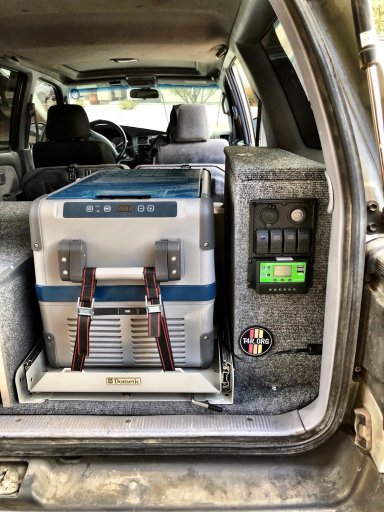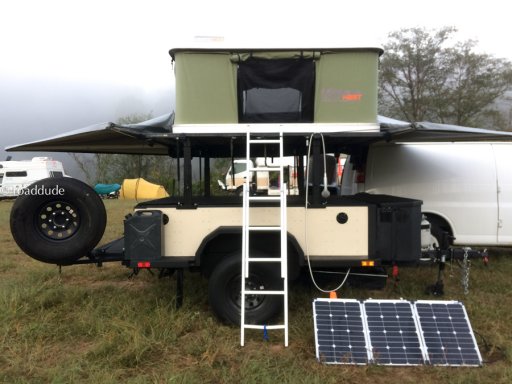controller display....poor photo sorry guys...View attachment 42983
Looks fine.
controller display....poor photo sorry guys...View attachment 42983

Member I




Member II
Very nice, sounds great and gives me a few ideas too :)when I was building my overland trailer, I wanted the trailer 100% off grid, no electrical land line hook up's at all. I had to figure what I was going to use as of equipment, what battery will do the job along with the size of battery or batteries.
1st my Engel 12v. 22qt Fridg\Freez draws .07 to 2amp, my Propex H2000 thermostatic tent heater draws 1.9 amps these will be used in early spring & late fall camping season, the late spring hot summer camping season will be the Engel 22qt.fridg\freez & the Mighty Kool K2 12v. A\C unit which only draws 1.8 amp. I gave all this information of what equipment I will run & times they will be running to Renogy & they came up with a nice portable system for my overland trailer build. The system contains 30amp Renogy Wander Charge Controller with battery temperature sensor, 20ft. 10 awg solar panel cable, 1 30 amp fuse (located in between charge controller 7 solar panel) with 2 100 watt suit case portable panels connected together (only one shown in my photo). The battery I run is a VMax Tank 125amp hr solar battery with a 10 to 12 yr life span.
What people forget is peak time running, how many amps your equipment takes to run, when will your equipment be used (day or night or 24hrs.) & how long in time frame will it be in use while camping, amount of sun light available.
For me the Engel will be on fridg only & will run 24hr but remember the fridg runs only on demand, the H2000 Propex tent heater run during sleeping hours which is thermostatically controlled & is a demand only too, the Mighty Kool K2 A\C unit will run sleeping hours continuously.
View attachment 45154 View attachment 45153
View attachment 45152
when I was building my overland trailer, I wanted the trailer 100% off grid, no electrical land line hook up's at all. I had to figure what I was going to use as of equipment, what battery will do the job along with the size of battery or batteries.
1st my Engel 12v. 22qt Fridg\Freez draws .07 to 2amp, my Propex H2000 thermostatic tent heater draws 1.9 amps these will be used in early spring & late fall camping season, the late spring hot summer camping season will be the Engel 22qt.fridg\freez & the Mighty Kool K2 12v. A\C unit which only draws 1.8 amp. I gave all this information of what equipment I will run & times they will be running to Renogy & they came up with a nice portable system for my overland trailer build. The system contains 30amp Renogy Wander Charge Controller with battery temperature sensor, 20ft. 10 awg solar panel cable, 1 30 amp fuse (located in between charge controller & solar panel) with 2 100 watt suit case portable panels connected together (only one shown in my photo). The battery I run is a VMax Tank 125amp hr solar battery with a 10 to 12 yr life span.
What people forget is peak time running, how many amps your equipment takes to run, when will your equipment be used (day or night or 24hrs.) & how long in time frame will it be in use while camping, amount of sun light available.
For me the Engel will be on fridg only & will run 24hr but remember the fridg runs only on demand, the H2000 Propex tent heater run during sleeping hours which is thermostatically controlled & is a demand only too, the Mighty Kool K2 A\C unit will run sleeping hours continuously.
View attachment 45154 View attachment 45153
View attachment 45152

Member I

Member III


Enthusiast III

I went for the portable option.ounted panel or go portable?

Member I



Advocate III
I agree with @DBs and @ArkansasDon. For the power needs most of us have for camping and backcountry travel, folding panels are wisest. Especially because you have your fridge in your vehicle, putting hard-mounted panels on your roof means you'll have to put your vehicle in the sun if you want solar gain while parked, which is usually when we need it most. It's only smart to keep your vehicle in the shade when you can while camping to keep it and its contents cooler.Read through this post and as a noob I have to ask. Would it make more sense for a roof mounted panel or go portable?
As you can see in pic I have a controller already wired up (10ga as suggested) and now I’m just trying to decide If I want something I can move around or something attached to my roof rack.

Real life test of my 120W panel with the new MPPT controller. Worked like a charm. Even in cloudy/overcast conditions.Plenty of detailed responses but I'll say "ditto." Fixed mount is convenient BUT you can't have your trailer or vehicle in the shade with the expectation your panel(s) will work efficiently. While I may add a panel to my trailer I still have a portable one with me. I have a rollup 60 watt and the Renogy suitcase. If/when I add a panel to the trailer I would maybe not bring the Renogy to save space but would always take the roll-up with me.
Lastly a portable setup is nice to share with others if you are group camping. If a friends battery is getting low I let them borrow my setup for a few hours.
Once lithium batteries become more affordable drain down will become less of an issue. The saying "My truck still started" doesn't really go along with battery longevity and health. Look at technical articles on battery voltage drop. It doesn't take long to get to below 50% and that is very bad for traditional AGM batteries.
Dang it this was more than ditto.... :)





Member III
Interesting...my 100 watt double panel was pulling the same rates. Have you been able to pull more at times?Real life test of my 120W panel with the new MPPT controller. Worked like a charm. Even in cloudy/overcast conditions.



Sent from my iPhone using OB Talk
Yes. The controller regulates the current as needed to charge the battery and run accessories, based upon the current solar conditions... if it needs 70W, it delivers just that. If more, it delivers more.Interesting...my 100 watt double panel was pulling the same rates. Have you been able to pull more at times?
Sent from my SM-G960U using OB Talk mobile app

Member III
Didn't know the MPPT regulated what the solar panel pulls. Hmmmmm!Yes. The controller regulates the current as needed to charge the battery and run accessories, based upon the current solar conditions... if it needs 70W, it delivers just that. If more, it delivers more.
Sent from my iPhone using OB Talk
http://www.iinno-led.com/mppt-vs-pwm-solar-controllers/Didn't know the MPPT regulated what the solar panel pulls. Hmmmmm!
Sent from my SM-G960U using OB Talk mobile app

Member III
I got this one, https://amzn.to/2L574aE.which BT controller do you use?
